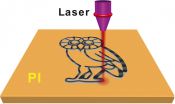(Press-News.org) Pioneering new research by the University of Exeter could revolutionise global diagnostic procedures for one of the most common forms of epilepsy.
Scientists from Exeter have investigated using mathematical modelling to assess susceptibility to idiopathic generalised epilepsy (IGE) by analysing electrical activity of the brain while the patient is in a resting state.
Current diagnosis practices typically observe electrical activities associated with seizures in a clinical environment.
The ground-breaking research has revealed differences in the way that distant regions of the brain connect with each other and how these differences may lead to the generation of seizures in people with idiopathic generalized epilepsies (IGE).
By using computer algorithms and mathematical models, the research team, led by Professor John Terry, was able to develop systems to analyse EEG recordings gathered while the patient is at rest, and reveal subtle differences in dynamic network properties that enhance susceptibility to seizures.
Professor Terry said: "Our research offers the fascinating possibility of a revolution in diagnosis for people with epilepsy.
"It would move us from diagnosis based on a qualitative assessment of easily observable features, to one based on quantitative features extracted from routine clinical recordings.
"Not only would this remove risk to people with epilepsy, but also greatly speed up the process, since only a few minutes of resting state data would need to be collected in each case."
The pivotal research has been published in a recent series of papers, the most recent of which has been published online in the scientific journal Frontiers in Neurology.
In their first study, EEG recordings were used to build a picture of how different regions of the brain were connected, based upon the level of synchrony between them. The collaborative team of researchers from Exeter and Kings College, London, then used a suite of mathematical tools to characterise these large-scale resting brain networks, observing that in people with IGE these networks were relatively over-connected, in contrast to healthy controls.
They further observed a similar finding in first-degree relatives of this cohort of people with IGE; an intriguing finding which suggests that brain network alterations are an endophenotype of the condition - an inherited and necessary, but not sufficient, condition for epilepsy to occur.
In a second study the team sought to understand how these alterations in large-scale brain networks could heighten susceptibility to recurrent seizures and thus the condition epilepsy. The study revealed two intriguing findings - firstly, the level of communication between regions that would lead to their activity becoming synchronised was lower in the brain networks of people with IGE, suggesting a possible mechanism of seizure initiation; and further that altering the activity in specific left frontal brain regions of the computational model could more easily lead to synchronous activity throughout the whole network.
In their most recent study, researchers have introduced the concept of "Brain Network Ictogenecity" (or BNI) as a probabilistic measure for a given network to generate seizures. They found that the brain networks of people with IGE had a high BNI, whereas the brain networks of healthy controls had a low BNI.
Professor Terry said: "Our most recent analyses have revealed that the average connectedness of each brain region is key to creating an environment where seizures can thrive.
This feature appropriately discriminates between cohorts of people with idiopathic generalized epilepsies and healthy control subjects. The next critical state of our research is to validate in a prospective study the predictive power of these findings."
INFORMATION:
For more information please contact:
University of Exeter Press Office
+44 (0)1392 722391
pressoffice@exeter.ac.uk
About the University of Exeter
The University of Exeter is a Russell Group university and in the top one percent of institutions globally. It combines world-class research with very high levels of student satisfaction. Exeter has over 19,000 students and is ranked 7th in The Times and The Sunday Times Good University Guide league table, 10th in The Complete University Guide and 12th in the Guardian University Guide 2014. In the 2008 Research Assessment Exercise (RAE) 90% of the University's research was rated as being at internationally recognised levels and 16 of its 31 subjects are ranked in the top 10, with 27 subjects ranked in the top 20. Exeter was The Sunday Times University of the Year 2012-13.
The University has invested strategically to deliver more than £350 million worth of new facilities across its campuses in the last few years; including landmark new student services centres - the Forum in Exeter and The Exchange on the Penryn Campus in Cornwall, together with world-class new facilities for Biosciences, the Business School and the Environment and Sustainability Institute. There are plans for another £330 million of investment between now and 2016.
http://www.exeter.ac.uk
"A tree must be bent while it is young," as one saying about learning a foreign language goes. In other words, the earlier you start learning a foreign language systematically, the better the language level will be in the long run. The second widely held view is that you need to be solid in your first language (L1) in order to develop good literacy skills in the foreign language. Linguist Simone Pfenninger from the University of Zurich has been examining these two myths in her five-year study involving Swiss high-school children in order to identify the optimal starting ...
Reston, Va. (December 9, 2014) - Cancer therapy can be much more effective using a new way to customize nuclear medicine treatment, researchers say in the December 2014 issue of The Journal of Nuclear Medicine. The process could also be useful for other diseases that could benefit from targeted radiation.
Targeted therapy with radiopharmaceuticals--radioactive compounds used in nuclear medicine for diagnosis or treatment--has great potential for the treatment of cancer, especially for cancer cells that have migrated from primary tumors to lymph nodes and secondary organs ...
London, United Kingdom, December 9, 2014 - As the Ebola Virus Diseases (EVD) epidemic continues to rage in West Africa, infectious diseases experts call attention to the striking lack of treatment guidelines. With over 16,000 total cases and more than 500 new infections reported per week, and probable underreporting of both cases and fatalities, the medical community still does not have specific approved treatment in place for Ebola, according to an editorial published in the International Journal of Infectious Diseases.
Not only are treatment guidelines lacking, but ...
Studying the social interaction of bears through the use of camera traps and visual observations requires that humans be able to tell individuals apart. A study done using volunteers to study the vulnerable Andean bear indicates that people can learn to identify individual bears, given a little practice. The research, done by San Diego Zoo conservationists with international collaborators using photos spanning many years, also indicates that young bears usually retain many of their unique markings as they grow older.
"Knowing, scientifically, that people who have been ...
Researchers from Johannes Gutenberg University Mainz (JGU) and the Julius Maximilian University of Würzburg are proposing potential new active substances for treating the dengue virus. Just like Ebola, dengue fever is also caused by a virus for which there is currently no cure and no vaccine and can be fatal.
In the quest for medication to treat the dengue virus, the scientific community is focusing on a particular enzyme of the pathogen, the protease known as NS2B/NS3. The reason for this is that inhibitors of similar proteases have been revealed to be very effective ...
JACKSONVILLE, Fla. -- A marker of immune function that predicts for better outcomes in patients treated with chemotherapy for triple negative breast cancer is also linked to improved prognosis in patients treated with chemotherapy for HER2-positive breast cancer. But that marker -- the quantity of tumor-infiltrating lymphocytes (S-TILs) in a biopsy -- appears irrelevant when trastuzumab is used.
And since trastuzumab, and not chemotherapy alone, is the standard of care for the HER2-positive sub-class of breast cancer, there is no need to test for these lymphocytes in ...
In patients with metastatic triple-negative breast cancer--a disease with no approved targeted therapies--infusion of pembrolizumab produced durable responses in almost one out of five patients enrolled in a phase-Ib clinical trial, according to data presented Dec. 10, at the 2014 San Antonio Breast Cancer Symposium.
The multi-center, non-randomized trial was designed to evaluate the safety, tolerability and antitumor activity of bi-weekly infusions of pembrolizumab (MK-3475, marketed as Keytruda®). The researchers enrolled 27 patients, aged 29 to 72 years, who had ...
Several past studies have suggested that the magnetic fields created by phones, high-voltage power lines and other electrical equipment are harmful for humans.
Research first carried out in the 1970's and again subsequently, found an association between people living near overhead power lines and an increased risk of childhood leukaemia. Although some later studies have failed to find such a link, the International Agency for Research on Cancer has categorised low frequency magnetic fields as "possibly carcinogenic."
But a mechanism for this association has never been ...
While many different combinations of genetic traits can cause autism, brains affected by autism share a pattern of ramped-up immune responses, an analysis of data from autopsied human brains reveals. The study, a collaborative effort between Johns Hopkins and the University of Alabama at Birmingham, included data from 72 autism and control brains. It will be published online Dec. 10 in the journal Nature Communications.
"There are many different ways of getting autism, but we found that they all have the same downstream effect," says Dan Arking, Ph.D. , an associate professor ...
HOUSTON - (Dec. 10, 2014) - Researchers at Rice University have created flexible, patterned sheets of multilayer graphene from a cheap polymer by burning it with a computer-controlled laser. The process works in air at room temperature and eliminates the need for hot furnaces and controlled environments, and it makes graphene that may be suitable for electronics or energy storage.
Under a microscope, what the researchers call laser-induced graphene (LIG) doesn't look like a perfect chicken wire-like grid of atoms. Instead, it's a jumble of interconnected graphene flakes ...

